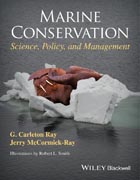
Marine Conservation: Science, Policy, and Management
Ray, G. Carleton
McCormick–Ray, Jerry
Jr., Smith, Robert L.
Providing a guide for marine conservation practice, Marine Conservation takes a whole–systems approach, covering major advances in marine ecosystem understanding. Its premise is that conservation must be informed by the natural histories of organisms together with the hierarchy of scale–related linkages and ecosystem processes. The authors introduce a broad range of overlapping issues and the conservation mechanisms that have been devised to achieve marine conservation goals. The book provides students and conservation practitioners with a framework for thoughtful, critical thinking in order to incite innovation in the 21st century. Marine Conservation presents a scholarly but eminently readable case for the necessity of a systems approach to conserving the oceans, combining superb introductions to the science, law and policy frameworks with carefully chosen case studies. This superb volume is a must for anyone interested in marine conservation, from students and practitioners to lay readers and policy–makers. —Simon Levin , George M. Moffett Professor of Biology, Department of Ecology & Evolutionary Biology, Princeton University INDICE: Contributors, ix Preface, xii About the companion website, xiv 1 IN PURSUIT OF MARINE CONSERVATION, 1 1.1 The emergence of modern marine conservation, 1 1.2 Defining marine conservation, 4 1.3 Marine conservation’s scope, 4 1.4 Adapting marine conservation to the 21st century, 5 2 MARINE CONSERVATION ISSUES, 7 2.1 Igniting marine conservation concern, 7 2.2 Primary issues: loss of marine biodiversity, 7 2.3 Secondary issues: human activities, 13 2.4 Tertiary issues: emergent and unintended consequences, 30 2.5 The challenge for the 21st century, 35 3 MARINE CONSERVATION MECHANISMS, 43 3.1 The toolkit, 43 3.2 Biological conservation, 43 3.3 Spatially explicit conservation, 48 3.4 Governance: policy, strategy, tactics, 50 3.5 Policy instruments for marine conservation, 54 3.6 Management concepts, 65 3.7 Agents for conservation, 68 3.8 Conclusion, 70 4 MARINE SYSTEMS: THE BASE FOR CONSERVATION, 74 4.1 A systems approach, 74 4.2 Dynamic planetary forces, 74 4.3 Major ocean structures and conditions, 78 4.4 Planetary cycles, 81 4.5 Major planetary interfaces, 82 4.6 The dynamic coastal realm, 86 4.7 The coastal realm: an ecosystem of global importance, 92 4.8 The ecosystem concept, 97 4.9 Ecosystem base for conservation, 99 5 NATURAL HISTORY OF MARINE ORGANISMS, 105 5.1 What is natural history?, 105 5.2 Darwinian evolution, 105 5.3 Diversity of marine life, 106 5.4 Life history, 112 5.5 Biological associations, 123 5.6 Biogeographic patterns in space and time, 126 5.7 Biotic functional diversity, 127 5.8 Seascape as an organizing principle, 131 5.9 Natural history: the basis for conservation, 132 6 CHESAPEAKE BAY: ESTUARINE RESTORATION WITH AN ENVIRONMENTAL DEBT, 137 6.1 The great shellfish bay, 137 6.2 Ecological linkages to natural wealth, 137 6.3 Eastern oyster: quintessential estuarine species, 151 6.4 From resource abundance to ecosystem change, 154 6.5 Bay restoration: chartering a course, 163 6.6 People shall judge, 165 7 BERING SEA SEALS AND WALRUSES: RESPONSES TO ENVIRONMENTAL CHANGE, 171 G. Carleton Ray, Gary L. Hufford, Thomas R. Loughlin and Igor Krupnik 7.1 A short history of dramatic change, 171 7.2 Biophysical setting, 172 7.3 Marine mammals of the southeastern Bering Sea, 174 7.4 Ice–dependent pinnipeds of the northern Bering Sea, 179 7.5 Do large marine mammals matter?, 186 7.6 The conflict arena, 191 7.7 Cultural factors: subsistence hunting, traditional knowledge, and community well–being, 194 7.8 Are Beringian pinnipeds and the Bering Sea ecosystem at risk?, 197 8 THE BAHAMAS: CONSERVATION FOR A TROPICAL ISLAND NATION, 200 8.1 A nation of islands, 200 8.2 Biophysical and social setting, 200 8.3 Conservation issues, 207 8.4 Governance for sustainability, 222 8.5 Island system at a crossroads, 230 9 THE ISLES OF SCILLY: SUSTAINING BIODIVERSITY, 234 Richard M. Warwick 9.1 Setting the scene, 234 9.2 Physical and biogeographic setting, 234 9.3 Measuring and measures of biodiversity, 237 9.4 Sustaining biodiversity from possible threats, 253 9.5 Conservation legislation, mechanisms, and voluntary actions, 256 9.6 The conservation status of Scilly, 260 10 GWAII HAANAS: FROM CONFLICT TO COOPERATIVE MANAGEMENT, 262 N. A. Sloan 10.1 Nation–to–nation pursuit of land–sea conservation, 262 10.2 Natural heritage, 263 10.3 Cultural and commercial heritage, 272 10.4 Integrating land–sea conservation, 278 10.5 Crucible for ecosystem–based management, 284 11 SOUTH AFRICA: COASTAL–MARINE CONSERVATION AND RESOURCE MANAGEMENT IN A DYNAMIC SOCIO–POLITICAL ENVIRONMENT, 288 Barry Clark and Allan Heydorn 11.1 A challenge for governance, 288 11.2 South Africa’s coastal realm: physical, biotic, and human setting, 289 11.3 Major conservation issues of South African coasts, 294 11.4 Coastal resource management: past and present, 303 11.5 In pursuit of the Kogelberg Biosphere Reserve, 306 11.6 The future of coastal management in South Africa, 311 12 SPECIES–DRIVEN CONSERVATION OF PATAGONIAN SEASCAPES, 315 Claudio Campagna, Valeria Falabella, and Victoria Zavattieri 12.1 Darwin?s Patagonia, 315 12.2 A conservation dilemma, 316 12.3 Oceanographic and biogeographic settings, 319 12.4 Conservation setting: the status of a non–pristine ocean, 322 12.5 Seascape species: a first approach to setting conservation priorities, 323 12.6 From seascape spaces to important foraging areas, 324 12.7 The concept of Large Ocean Reserves, 326 12.8 A first step towards a Patagonian Sea LOR: candidate areas for conservation, 331 12.9 Making slow progress, 335 References, 336 Suggested readings, 337 13 FROM BEING TO BECOMING: A FUTURE VISION, 339 13.1 The new normal, 339 13.2 From being . . . , 339 13.3 . . . to becoming, 340 13.4 Emerging concepts for marine conservation, 344 13.5 Look to the future, 353 References, 353 Species index, 357 Subject index, 361
- ISBN: 978-1-118-71444-7
- Editorial: Wiley–Blackwell
- Encuadernacion: Rústica
- Páginas: 384
- Fecha Publicación: 06/12/2013
- Nº Volúmenes: 1
- Idioma: Inglés
